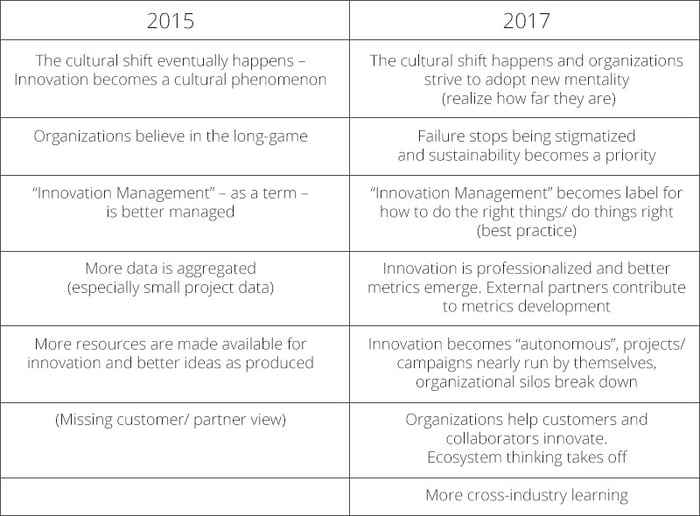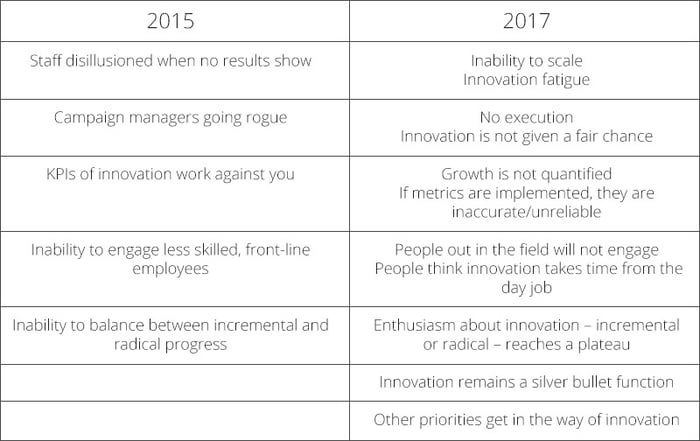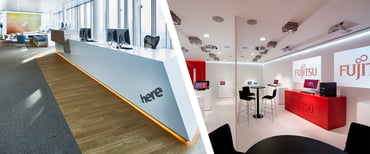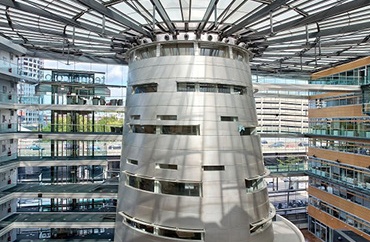It’s been exactly two years since I last attended HYPE’s Regional Forum in London (hosted, then too, by Fujitsu). Looking back at my impressions from the visit in 2015, I realize quite a few things have changed. And all for the better.
For example, the opening exercise called “hopes and fears of the innovation manager” generated deeper insights. Similarly, the mix of companies was more varied, as were the questions during the Q&A. Finally, HYPE’s “Inspire” platform was now the preferred (virtual) space to continue the conversation, create campaigns around topics of interest, and share useful materials and presentations.
So which big ideas were circulated this year? Read on to find out.
Hopes and fears - reloaded
Back in 2015, the London Forum’s attendees shared a variety of (perfectly legitimate) hopes. On the one hand, the managers in the room were eager to see the cultural shift finally happen, for the term “innovation management” to be used correctly, and for organizations to have long-term perspective. On the other hand, they were preoccupied with gathering more and better data on innovation projects and well as with making more resources available for innovation. Fast-forward to 2017 and the desire for cultural change remains, as does the hope that failure stops being stigmatized. Instead of just worrying about the fate of the label, attendees this year hoped “innovation management” becomes a real umbrella for best practice. Moreover, managers voiced the need for NPD processes to be professionalized, for innovation to happen on auto-pilot and for more cross-industry learning to take place. Most importantly, however, this year attendees hoped their organization would start moving in sync with customers, decision-makers, competitors, suppliers and other stakeholders; in other words that ecosystem thinking is embraced.
Top hopes of the innovation manager - 2015 vs 2017

In terms of “anxieties”, 2015 was marked by the fear that staff reject innovation. Specifically, that employees stop contributing early on (drop off quickly when results fail to show) or (even worse) that campaign managers “go rogue”. Other fears involved KPIs working against the business (flawed measures) and the inability to become an ambidextrous organization (where incremental and radical innovation capabilities co-exist). While some of these “anxieties” were gone in 2017, others had quickly replaced them. For example, staff disillusionment was overtaken by the inability to scale and, more generally, innovation fatigue. The fear of unsupportive campaign managers was now an even larger fear of innovation not being given a fair chance. Finally, the KPI issue had become a more general issue of growth failing to be quantified. New concerns this year involved enthusiasm reaching a plateau, innovation remaining a silver-bullet function (instead of the normal way of doing things) and other priorities getting in the way of innovation.
Top fears of the innovation manager - 2015 vs 2017

Reference points
Another key discussion point at the London Forum was the open innovation journey. Should organizations think in terms of dichotomies? – e.g., Open or closed, product or service oriented, applying a technology-push or market-pull strategy etc. Or are things more nuanced and fluid than that?
In reality, no organisation is ever at the far end (see white paper). That is, no organization is perfectly closed or perfectly open in its approach to innovation. Instead, all organizations move, with varying speed, along a continuum.
According to management research, each organization typically starts by seeing its products as inherently valuable. As it matures, it recognises that value can only be judged by the customer. Eventually, it will routinely engage in co-creation with the customer(s) and evolve with them. Otherwise put, the organization will migrate from simpler forms of collaboration such as supplier alliances/partnerships and portfolios (perfectly suited for product-logic), to more sophisticated arrangements such as networks and even ecosystems (better suited for service-logic/ orientation). In these latter case, organizations will also witness new and interesting phenomena like: shared governance models, less strict IP regimes, role fluidity, resource pooling etc.
In light of such continuums, innovation managers must consider the reference points (the extremes) and periodically assess where they are in relation to them.
Big questions that remain
While the London Forum managed to provide managers with some answers, a number of big questions still remain. These include, but are not limited to:
What options for collaboration are there? And how should organizations pick?
What are the advantages and disadvantages of these options? For example: is in-licensing IP better than donating IP? Or how do corporate incubators fair against doing research with a university? And can these modes even be meaningfully compared?
What types of open innovation partners are there? What is the role of each?
How do the “institutions” (rules and norms of collaboration) enable or constrain innovation and how to recognise them? For example, how does organizational culture affect innovation and collaboration? What about national laws or general beliefs of the customers?
I guess we will have to wait for the next Forum to get some answers.










